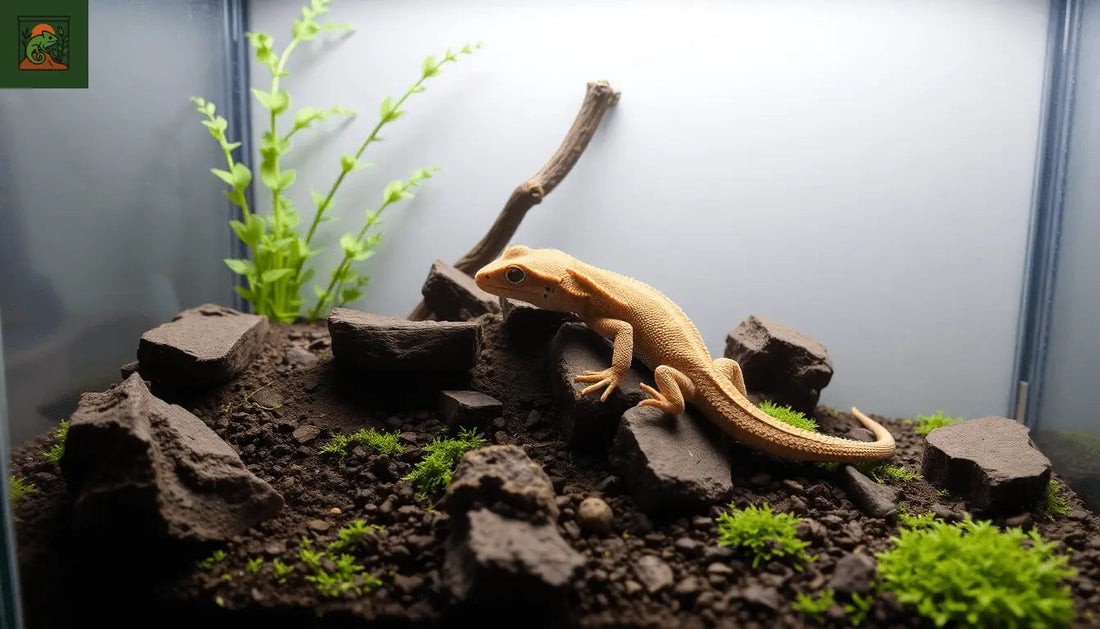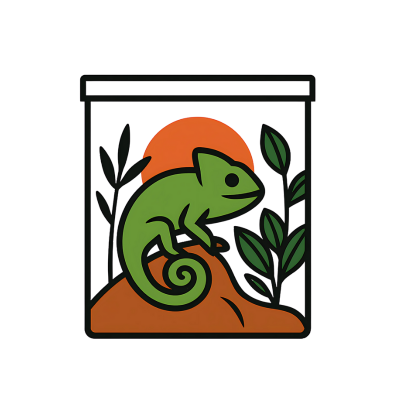
One Species, One Terrarium
Leopard Gecko in a Terrarium : Everything You Need to Install It Properly at Home (2024)
The leopard gecko (Eublepharis macularius) is a favorite among reptile enthusiasts. Calm, hardy, and easy to keep, it's perfect for beginners in terrarium keeping. But for it to thrive, a well-designed terrarium is essential.
Here isle-terrarium.com 's simple and comprehensive guide to successfully installing it step by step.

1. Focus on the Species: The Leopard Gecko
The leopard gecko (Eublepharis macularius) is one of the most popular reptiles among terrarium enthusiasts, and for good reason: it's fascinating, docile, and easy to keep. Native to the desert regions of Asia (Pakistan, India, Afghanistan), this small nocturnal lizard is captivating with its spotted patterns reminiscent of a leopard's coat.
With an average adult size of 20 to 25 cm, the leopard gecko has soft skin covered with granular scales, a fleshy tail that stores fat reserves, and mobile eyelids – a rarity among geckos! It is also famous for its wide variety of colors and morphs, bred in captivity.
Behaviorally, it's a calm, curious, and non-aggressive reptile. Ideal for beginners, it tolerates handling well if it's gentle and gradual. Its nocturnal lifestyle makes it a discreet observer of your terrarium, where it will enjoy exploring hiding places and basking under a heat lamp.
For its well-being, provide a terrarium at least 60 cm long, with suitable flooring (absorbent paper, reptile carpet or secure substrate), warm and cool hiding places, a warm spot at 32 °C, and moderate humidity. Its diet consists mainly of live insects (crickets, mealworms, cockroaches), dusted with calcium.
The leopard gecko is therefore a perfect reptilian companion for discovering the world of terrariums, combining aesthetics, captivating behavior and accessible maintenance.
-Origin: Pakistan, Afghanistan, India
-Adult size: 20 to 25 cm
-Life expectancy: 15 to 20 years
-Character: calm, discreet, nocturnal
-Lifestyle: terrestrial, burrowing
-Natural climate: arid and semi-desert
2. Recommended Terrarium Dimensions
| Number of geckos | Minimum terrarium size |
|---|---|
| 1 adult | 60 x 45 x 45 cm |
| 2 females | 90 x 45 x 45 cm |
🛑 Never two males together! The risk of fighting is high.
3. Which Terrarium to Choose?
Choosing the right terrarium is an essential step in ensuring the health and well-being of your reptile. It all depends on the species you're keeping, its temperature, humidity, and space requirements, as well as its lifestyle (terrestrial, arboreal, or aquatic).
For a terrestrial reptile like the leopard gecko or bearded dragon, choose a horizontal terrarium with a large floor space. On the other hand, arboreal species like chameleons will need a vertical model with height and branches for climbing.
Materials side:
- Glass provides excellent visibility but retains heat less well.
- PVC or rigid plastic provides very good thermal insulation.
- Melamine wood is suitable for large models, but less recommended in humid environments.
Make sure you choose a terrarium with dimensions adapted to the adult size of your animal, good ventilation, and the essential equipment: heating system, UVB neon lights, hiding places, thermometers, etc.
🛒 Need help or inspiration? Discover our selection of ready-to-use terrariums on Le-Terrarium : models designed by enthusiasts to provide your reptiles with a healthy, safe, and aesthetically pleasing habitat.
4. The Right Substrate for a Leopard Gecko
The ground must allow some digging, while avoiding the risk of intestinal obstruction.
✅ Recommended substrates:
- Reptile rug or carpet
-Paper towels (for young people)
-Tile, slate or slab
❌ Avoid: fine sand, wood chips, dusty earth
5. Temperature and Heating
The leopard gecko needs a well-defined thermal gradient:
The well-being of the leopard gecko depends largely on a well-structured thermal gradient in its terrarium. This means that it must be able to choose between a warmer area and a cooler area, just as it would in the wild.
💡 To do this, install a heating mat under about a third of the terrarium, preferably placed outside under the glass. This creates a warm zone between 30 and 32°C, while the cold zone will remain around 24 to 26°C.
For optimal control, the use of a dual-probe thermometer is highly recommended. It allows you to accurately monitor temperatures at both ends of the terrarium and easily adjust them if necessary.
👉 All the accessories needed to maintain this thermal gradient are available in our Le-Terrarium store, carefully selected to guarantee comfort and safety for your companion.

6. Light and Day/Night Cycle
Even though he is nocturnal, he needs a stable rhythm:
-Photoperiod: 12h day / 12h night
-LED lighting: to simulate daylight
-UVB (optional): low intensity (type 2.0)
7. Terrarium Arrangement
Add:
-A hiding place in the hot zone
-A cool hiding place
-A damp hiding place (with moss) for moulting
-A heating stone or platform
-Two bowls: water and calcium
8. Leopard Gecko Diet
It is a strict insectivore. To give:
-Crickets, cockroaches
-Mealworms (in small quantities)
-Morios (in moderation)
🍽️ Sprinkle each meal with calcium + vitamin D3.

9. Daily Maintenance of the Terrarium
- Remove waste every day
- Clean the windows regularly
- Disinfect accessories every week
- Change the substrate every 15 to 30 days
- Replace the UVB lamp every 6 months if used
❓ FAQ – Leopard Gecko in Terrarium
1. Can we use sand?
No, it can be dangerous if ingested. Use solid surfaces instead.
2. Does the gecko need humidity?
Only in a hiding place for molting. The general environment remains dry (30 to 40% humidity).
3. Can several geckos live together?
Two females, yes. Two males, never. One male + one female = possible reproduction.
4. How often to feed?
-Juvenile: every day
-Adult: 3 to 4 times per week
5. Do I need a heat lamp?
Not necessarily. A heating mat is often sufficient, provided the temperature remains stable.
6. What is the average longevity?
With good care, a leopard gecko can live 15 to 20 years.
🦎 Conclusion
The leopard gecko is a docile, discreet, and endearing companion. Provide it with a suitable habitat, and it will amaze you with its behavior and robustness. With the practical advice from le-terrarium.com, create a safe and aesthetically pleasing environment, ideal for its well-being.
